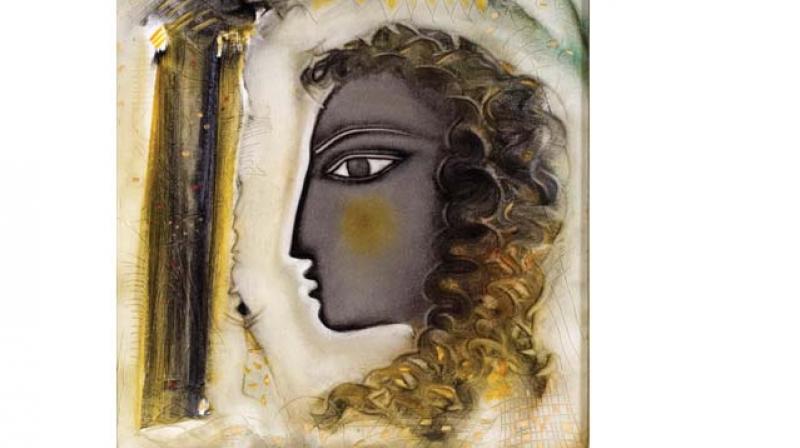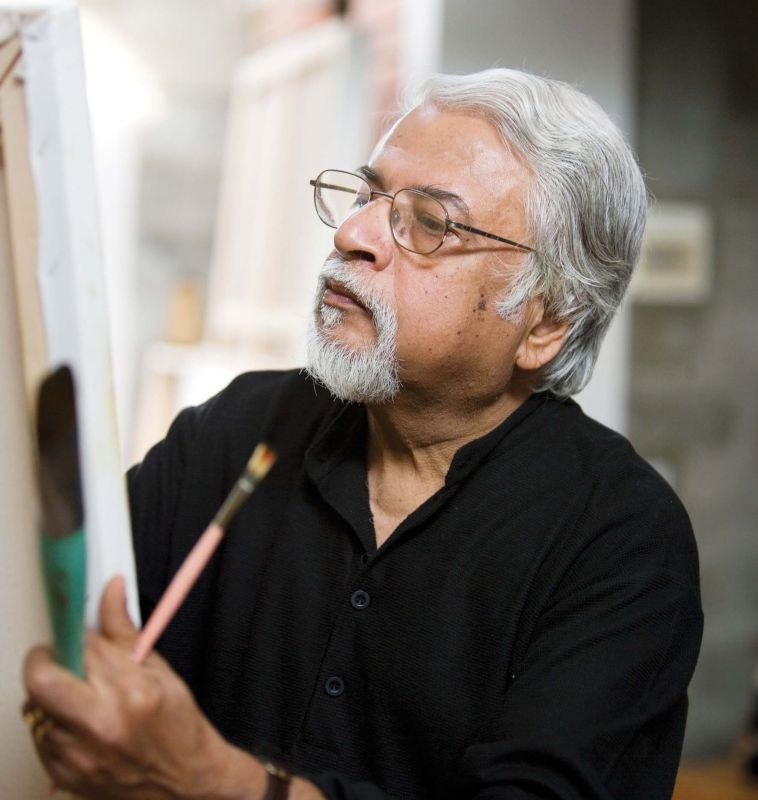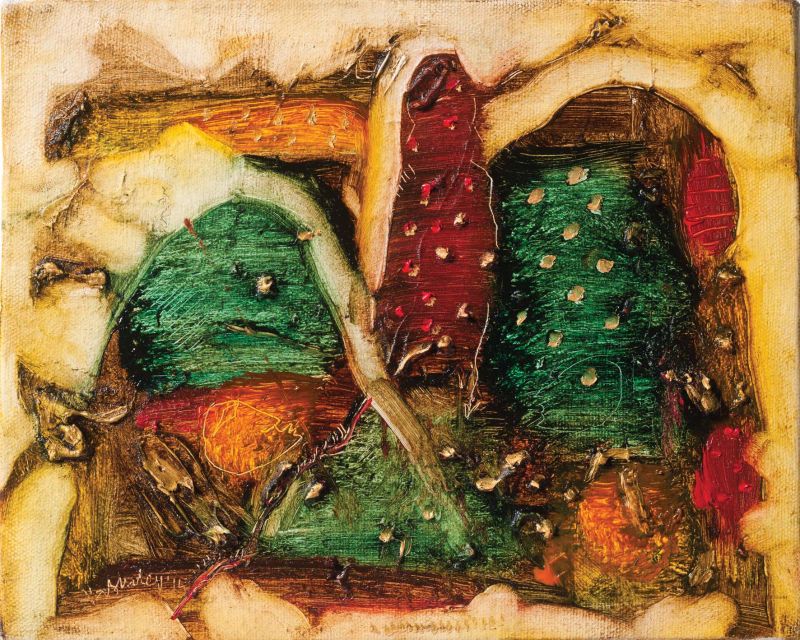Return to Sama: Roots in heaven, branches in the earth

"... like a musical cycle, keeps returning to sama, before it spins off into the next avartana."
Philosophical outpourings are hardly the domain of artist S.G. Vasudev. Expression for him is contained entirely in his art. “You should ask Sadanand about that line,” he says at once, referring to his curator and long-time friend. “He came up with it.”
Vasudev has, however, over the last five decades of his career, experimented with form and subject, throwing himself with passion into music, theatre and poetry. Still he returns, with new eyes each time, to the tree. Underneath it all is his romance with the ‘line’ – this is where all his paintings begin. It is also the focus of P. Sadanand’s curation – he has stepped away from the usual parameters of chronology, medium and type which usually dictate the putting together of a retrospective. “It all comes back to the line. I could place a line drawing next to a painting from a Tree series and the onlooker will be able to make the connection.”
That is how Vasudev explains his works too, pausing near every painting that catches his eye to feign his actions with the paintbrush. The earlier paintings are reminiscent of an angry, intense hand, his brush, often hardened after days of use, making bold outlines across the canvas. Even colour is used with great prudence: “I think every colour has its beauty. Only one will dominate a single canvas.” It was only later that he began to work with layers, starting out with a base of acryclic, adding more colour and then scraping it off. “Even white on white is a complete canvas,” he remarks. “I’m still not at the place where I can leave it at that, though!”
 S.G. Vasudev
S.G. Vasudev
In two days, S.G. Vasudev will launch ... a retrospective of his work, at the National Gallery of Modern Art. The first question that arises is: how can one month possibly be enough? Vasudev, whose career as an artist began in Chennai in the 1960s, is a doyen of South Indian culture. Poets, musicians, actors and of course, artists of all kinds, have plenty to thank him for: over the years, Vasudev has used his own medium to bridge the growing gaps between art and the other forms of creative expression.
"It's quite a new trend, that," reflects poet Prathibha Nandakumar, who sits down for a cup of coffee with her old friend, Vasudev, at the NGMA. Prathibha is putting together one segment of the show too: a soliloquy inspired by Vasudev's notes, that attempt to explore the inner workings of the artist. Vasudev himself looks remarkably relaxed, bearing in mind the magnitude of the show at hand. "I'm not taking on the coordination this time," he laughs, ducking across the lawn and through a small back entrance to new wing.
Here, craftsmen balance precariously along the railings, where motifs from Vasudev's works are being pasted. Orchestrating the process is Miti Desai, dancer and designer, who is conceptualising the exhibition itself. The approach to the new wing already bears traces of her touch, with blackened walls covered in bold text and works placed along the way. A few more banners will add to the drama, Desai says, although these weren't up at the time. "I want drama and intensity outside," she explains. "The idea is to create an experience of the artist and his work, one that will immerse the audience from the moment he or she enters the grounds." One of Vasudev's larger copper reliefs makes an imposing welcome to the gallery space itself, where the works were being placed. "Inside, it's about the works themselves. We don't want to take away from that." An enclosure is in the midst of being erected in the centre: it's a surprise, Vasudev smiles.

The conversation is peppered by many a phone call as Vasudev deals with the last odds-and-ends of preparation. Inner Resonance- a return to Sama, will feature over 300 works, taken. One of the best known contemporary modernists, S.G. Vasudev's work, as well as his artistic presence, has contributed tremendously to the artist community. As a student in the Madras Arts College, S.G. Vasudev was spellbound his his teacher and mentor, K.C.S. Panicker.
Artists at the time had very little hope of making a living and Vasudev broke away with a group of friends to explore a rebellious idea at the time: art as a profession. It led to the foundation of the Cholamandal Artists' Village in Chennai, where craftsmen from all over were brought in. "It was the first time artists had considered bringing fine arts together with handicrafts," Vasudev recalls. The intricate copper reliefs, which dominate one corner of the wing, are a nod to his Cholamandal days. "That's where I first learned to make a copper a relief," he says. It's an intensive, demanding process, as most of Vasudev's chosen mediums tend to be. A lacquer is prepared with brick powder, gum and oil, then brought to a boil. The sheet of copper is placed on this and allowed to cool, after which it can be beaten into shape. “I have some 60 tools to do this,” says Vasudev. Tapestries made in silk, depicting works from all his series, will present a bold display too, for Vasudev intends to have them suspended fr
om the ceiling.
Glimpses from series like Tree of Life, Tree of Life and Death, She and Tree and Earthscape are already on display. Collectors from around the world have sent their works in for the exhibition, Vasudev pauses beside one, saying, “This is from Kiran Mazumdar-Shaw. It hangs on a wall in her office, still.” The National Gallery of Modern Art has also sent in works taken from its private collection. In Earthscapes, the Tree takes on darker connotations: here, we see human beings with expressions of agony and the tree itself is mutilated. “This is what we have done, as human beings,” Vasudev says. “But we will destroy ourselves too. We are not separate from the trees, we are not apart from nature.” The line drawings occupied a section of their own many of these have been inspired by the poet A.K. Ramanujan. Vasudev did the art work for the cover of Ramanujan's Hokkulalli Hoovilla.
A number of events have been lined up for the month, including a performance by Madhu Natraj, animated line drawings and poetry. “I have many interests and I would like them all to come together,” Vasudev says emphatically.
A retrospective comes with its own melancholic underpinnings and the ‘return to sama’ best describes this one. Vasudev slips away quietly and finds a corner, where he watches craftsmen at work along the stairs. The artist in pursuit of solitude is a cliche, too much so for Vasudev. "I'm actually considering drawing on those walls," he says, laughing as he imagine's the administration's surprise. “Every artist needs to do a retrospective, to look back, to return to his works. I have spoken through my art and now, my art will speak to me.” Still, he says, “I’m returning to work in November! Who knows, maybe I’ll be back here in 10 years, all ready with another retrospective!”
What: Inner Resonance- a return to Sama
When: September 1 to 30
Where: NGMA, Palace Road

